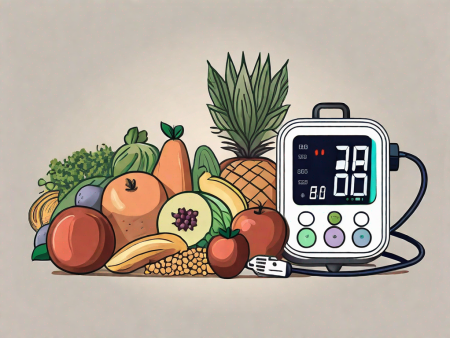Discover the most prevalent types of cancer that affect older men.
What Are the Most Common Cancers in Older Men?
As men age, their bodies undergo numerous changes, and unfortunately, that includes an increased risk of developing certain types of cancer. But fear not, gentlemen! With a little knowledge and understanding of the most common cancers in older men, you’ll be able to arm yourself in the battle against these sneaky foes.

Understanding the Risk Factors for Cancer in Older Men
First things first, let’s delve into the various risk factors that can contribute to the development of cancer in older men. Age plays a crucial role in cancer development, and as the years go by, our bodies become more susceptible to these microscopic troublemakers.
But it’s not just age that’s to blame. Lifestyle factors also contribute to our vulnerability. So, put down that bacon sandwich for a moment and listen up! Certain habits such as smoking, excessive alcohol consumption, and a lack of exercise have been linked to an increased risk of cancer. It’s never too late to adopt healthy habits and give those cancer cells a run for their money!
Now, let’s not forget about our genes. Sadly, some of us may have inherited a genetic predisposition to certain types of cancer. But fear not! With advancements in medical research, we can now detect and manage these genetic factors more effectively.
As we age, our bodies undergo various changes that can make us more susceptible to cancer. One such change is a decline in the immune system’s ability to detect and destroy abnormal cells. This weakened immune response can allow cancer cells to proliferate and form tumors.
Additionally, older men may have a higher likelihood of being exposed to environmental factors that can increase their risk of cancer. For example, prolonged exposure to certain chemicals or toxins in the workplace or through hobbies can contribute to the development of cancer. It’s important for older men to be aware of their surroundings and take necessary precautions to minimize exposure to harmful substances.
Furthermore, hormonal changes that occur with age can also impact cancer risk in older men. For instance, a decrease in testosterone levels can affect prostate health and potentially increase the chances of developing prostate cancer. Regular screenings and discussions with healthcare professionals can help detect and manage these hormonal changes.
When it comes to lifestyle factors, smoking remains one of the most significant contributors to cancer risk in older men. The harmful chemicals in tobacco smoke can damage DNA and other genetic material, leading to the formation of cancerous cells. Quitting smoking, even later in life, can significantly reduce the risk of developing various types of cancer.
Excessive alcohol consumption is another lifestyle factor that can increase cancer risk. Alcohol can damage cells and interfere with the body’s ability to repair DNA damage, increasing the likelihood of cancer development. Limiting alcohol intake or abstaining altogether can have a positive impact on overall health and reduce the risk of cancer.
Physical activity, or the lack thereof, also plays a role in cancer risk. Regular exercise can help maintain a healthy weight, boost the immune system, and reduce inflammation in the body, all of which contribute to a lower risk of cancer. Older men should aim for at least 150 minutes of moderate-intensity aerobic activity per week, along with strength training exercises.
While age and lifestyle factors are significant contributors to cancer risk, genetics can also play a role. Certain inherited gene mutations can increase the likelihood of developing specific types of cancer, such as breast, ovarian, or colorectal cancer. Genetic testing and counseling can help identify these genetic predispositions and guide appropriate preventive measures.
In conclusion, understanding the risk factors for cancer in older men is crucial for early detection and prevention. Age, lifestyle factors, and genetics all play a role in determining individual risk. By adopting healthy habits, minimizing exposure to harmful substances, and staying informed about genetic predispositions, older men can take proactive steps to reduce their risk of cancer and lead healthier lives.
The Prevalence of Different Cancers in Older Men
Alright, now that we know about the risk factors, let’s shed some light on the most prevalent cancers in older men.
As men age, their risk of developing cancer increases. It is important to be aware of the different types of cancer that older men are more prone to, as early detection and treatment can make a significant difference in outcomes.
Prostate Cancer: A Leading Health Issue
Gentlemen, you’ve probably heard about this one, as it steals the spotlight when it comes to cancer in older men. Prostate cancer affects the walnut-sized gland responsible for producing semen. The prostate gland is located just below the bladder and surrounds the urethra, the tube that carries urine and semen out of the body.
Prostate cancer is the most common cancer among men, and the risk increases with age. It is estimated that about 1 in 9 men will be diagnosed with prostate cancer during their lifetime. The good news is that early detection through regular screenings can significantly improve the chances of successful treatment.
Screening for prostate cancer typically involves a blood test called the prostate-specific antigen (PSA) test, which measures the level of PSA in the blood. Elevated PSA levels may indicate the presence of prostate cancer, but further tests, such as a biopsy, are needed to confirm the diagnosis.
Lung Cancer: A Persistent Threat
Ah, the dreaded lung cancer. This sneaky villain often goes undetected until the later stages, making it one of the trickiest cancers to treat. Lung cancer occurs when abnormal cells grow uncontrollably in the lungs, usually in the cells that line the air passages.
Smoking is the leading cause of lung cancer, and it is estimated that about 85% of lung cancer cases are directly linked to smoking. However, it’s important to note that non-smokers can also develop lung cancer, often due to exposure to secondhand smoke, environmental pollutants, or genetic factors.
The most effective way to prevent lung cancer is to avoid smoking and secondhand smoke like the plague. If you are a smoker, quitting smoking can significantly reduce your risk of developing lung cancer and improve your overall health.
Colorectal Cancer: A Silent Killer
Colorectal cancer, or as some like to call it, the silent killer. This type of cancer affects the colon or rectum, which are parts of the digestive system. Colorectal cancer usually begins as small, noncancerous growths called polyps that can develop into cancer over time.
Unfortunately, colorectal cancer often shows no symptoms until it reaches an advanced stage. That’s why regular screenings and paying attention to any unusual changes in your digestive system are key in catching it early!
Screening for colorectal cancer can involve various methods, such as a colonoscopy, sigmoidoscopy, or stool tests. These tests can help detect polyps or abnormal cells in the colon or rectum, allowing for early intervention and treatment.
It is important to note that lifestyle factors, such as a diet high in red and processed meats, lack of physical activity, obesity, and smoking, can increase the risk of developing colorectal cancer. Making healthy lifestyle choices, such as maintaining a balanced diet, engaging in regular exercise, and avoiding tobacco, can help reduce the risk of colorectal cancer.
Symptoms and Early Detection of Common Cancers
Now that we know the big contenders, let’s dive into recognizing the red flags and detecting these cancers at the earliest possible stage.
Early detection is crucial when it comes to cancer. The sooner it is detected, the better the chances of successful treatment and improved outcomes. Being aware of the symptoms and knowing what to look out for can make a significant difference in the fight against cancer.
Recognizing the Signs of Prostate Cancer
Gentlemen, pay attention to your bodies! Prostate cancer is one of the most common cancers among men, but the good news is that it can often be detected early. Warning signs of prostate cancer may include difficulty urinating, blood in the urine, or a frequent need to urinate. However, it is important to note that these symptoms can also be caused by other conditions, so it’s essential to consult your healthcare provider for a proper diagnosis.
In addition to the symptoms mentioned above, other signs that may indicate prostate cancer include pain or discomfort in the pelvic area, bone pain, erectile dysfunction, or blood in the semen. These symptoms should not be ignored, and it is crucial to seek medical attention if they persist or worsen.
Symptoms of Lung Cancer to Watch Out For
Lung cancer is a serious condition that requires early detection for effective treatment. It is important to be aware of the symptoms and seek medical advice if any of them are present. Common symptoms of lung cancer include persistent coughing, hoarseness, shortness of breath, or unexplained weight loss.
It’s important to note that these symptoms can also be caused by other respiratory conditions, such as bronchitis or pneumonia. However, if you are experiencing any of these symptoms and they persist for an extended period, it is crucial to consult a healthcare professional for further evaluation.
Early Detection of Colorectal Cancer
Colorectal cancer, which includes cancers of the colon and rectum, is the third most common cancer worldwide. Detecting colorectal cancer early can significantly improve the chances of successful treatment. It is essential to be aware of the signs and symptoms and take prompt action if any are present.
Some common signs of colorectal cancer include changes in bowel habits, such as persistent diarrhea or constipation, bloody stool, abdominal pain or cramping, unexplained weight loss, or fatigue. These symptoms should not be ignored, especially if they persist for more than a few weeks.
It is important to note that these symptoms can also be caused by other conditions, such as hemorrhoids or irritable bowel syndrome. However, if you experience any of these symptoms, it is crucial to consult a healthcare professional for a proper evaluation and diagnosis.
Remember, knowledge is power when it comes to cancer. Being aware of the symptoms and early detection methods can help save lives. If you notice any unusual changes in your body or experience any of the mentioned symptoms, don’t hesitate to seek medical advice. Regular check-ups and screenings can also play a significant role in detecting cancer at its earliest stages, when treatment options are most effective.
Treatment Options for Common Cancers in Older Men
Alright, gentlemen, let’s talk about the big guns – the treatment options available to fight these cancers head-on!

Modern Approaches to Prostate Cancer Treatment
When it comes to prostate cancer, treatments range from surgeries to remove the prostate gland to radiation therapy and hormone therapy. Your healthcare provider will determine the best approach based on your specific case. Remember, it’s essential to discuss all available options and potential side effects with your doctor.
Lung Cancer: From Diagnosis to Treatment
Diagnosing lung cancer often involves a combination of imaging tests, biopsies, and blood work. Treatment options may include surgery, radiation therapy, chemotherapy, targeted therapy, or immunotherapy. Consult with your healthcare provider to determine which treatment plan is best for you.
Treating Colorectal Cancer: What to Expect
Treatment for colorectal cancer may include surgery, chemotherapy, radiation therapy, targeted therapy, or immunotherapy, depending on the stage and location of the cancer. Your healthcare team will guide you through the process and tailor the treatment to your specific needs.
Remember, gentlemen, knowledge is power! Understanding the most common cancers in older men, their risk factors, symptoms, and treatment options will help you stay one step ahead in the battle against these sneaky foes. So, take charge of your health, adopt a healthy lifestyle, stay vigilant for any warning signs, and consult your healthcare provider for regular screenings. Together, we can conquer these cancers and live life to the fullest!






